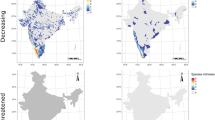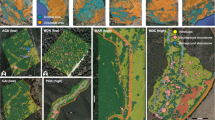Abstract
As a matter of fact, Araucaria angustifolia populations occur predominately in small and isolated stands; only a minor number of continuous natural forests of this dioecious wind-pollinated coniferous tree species remain. To implement reasonable conservation, breeding and restorations program it is necessary to have the knowledge of pollen dispersal distance and fine-scale genetic structure. In this paper, levels and dispersion distance of pollen and spatial genetic structure of A. angustifolia were investigated in a 14 ha transect in a continuous forest in Paraná State, Brazil. Analyses have been performed by the use of eight microsatellite loci, paternity and TwoGener approaches, and spatial autocorrelation analysis. In transect, 52 male and 56 female adult trees were mapped and genotyped, together with 190 seeds. In the present transect, A. angustifolia show spatial genetic structure at distances up to 75 m. Paternity analysis indicated that 54% of seeds were fertilized by pollen from trees outside the transect. The calculated average pollination distance within transect was 102 and 98 m based on the paternity analysis and TwoGener analysis, respectively. We found a significant pollen gene pool structure across seed-trees ( \(\widehat\Phi _{ft} = 0.078\), P < 0.01) that corresponds to an effective number of pollen donors of 6.4 male trees or an effective pollination neighbourhood area (A ep ) of 2.1 ha. The findings suggest long-distance pollen dispersion (>100 m) inside the continuous forest. However, the high proportion occurs in short-distance producing biparental and correlated mating as well as reducing the variance effective size.



Similar content being viewed by others
References
Austerlitz F, Smouse PE (2001a) Two-generation analysis of pollen flow across a landscape. II. Relation between Φ ft , pollen dispersal, and inter-female distance. Genetics 157:851–857
Austerlitz F, Smouse PE (2001b) Two-generation analysis of pollen flow across a landscape. III. Impact of adult population structure. Genet Res 78:271–280
Austerlitz F, Smouse PE (2002) Two-generation analysis of pollen flow across a landscape. IV. Estimating the dispersal parameters. Genetics 161:355–363
Bacles CFE, Burczyk J, Lowe AJ, Ennos RA (2005) Historical and contemporary mating patterns in remnant populations of the forest tree Fraxinus excelsior L. Evolution 59:979–990
Bittencourt JM, Sebbenn AM (2007) Patterns of pollen and seed dispersal in a small fragmented population of a wind pollinated Araucaria angustifolia in southern Brazil by paternity analysis. Heredity (in press)
Burczyk J, Koralewski TE (2005) Parentage versus two-generation analyses for estimating pollen-mediated gene flow in plant populations. Mol Ecol 14:2525–2537
Burczyk J, Adams WT, Shimizu JY (1996) Mating patterns and pollen dispersal in a natural knobcone pine (Pinus attenuata Lemmon) stand. Heredity 77:251–260
Burczyk J, DiFazio SP, Adams WT (2004) Gene flow in forest trees: how far do genes really travel. Forest Genet 11:1–14
Carvalho PER (2003) Espécies arbóreas brasileiras. Embrapa Informação Tecnológica, Brasília
Carvers S, Degen B, Caron H, Lemes MR, Margis R, Salgueiro F, Lowe AJ (2005) Optimal sampling strategy for estimation of spatial genetic structure in tree populations. Heredity 95:281–289
Cascante A, Quesada M, Lobo JJ, Fuchs EA (2002) Effects of dry tropical forest fragmentation on the reproductive success and genetic structure of the tree Samanea saman. Cons Biol 16:137–147
Cockerham CC (1969) Variance of gene frequencies. Evolution 23:72–84
Degen B (2006) Genetic data analysis and numerical test. GDA-NT. Beta version 1.0
Degen B, Streiff R, Ziegenhagen B (1999) Comparative study of genetic variation and differentiation of two pedunculate oak (Quercus robur) stands using microsatellite and allozyme loci. Heredity 83:597–603
Devlin B, Ellstrand NC (1990) The development and application of refined methods for estimating gene flow from angiosperm paternity analysis. Evolution 44:248–259
Dow BD, Ashley MV (1998) High levels of gene flow in bur oak revealed by paternity analysis using microsatellites. J Hered 89:62–70
Dyer RJ, Sork LJ (2001) Pollen pool heterogeneity in shortleaf pine, Pinus schinata Mill. Mol Ecol 10:859–866
El-Kassaby YA, Jaquish B (1996) Population density and mating pattern in western larch. J Hered 87:438–443
Ennos RA (1994) Estimating the relative rates of pollen and seed migration among plant populations. Heredity 72:250–259
Fernández-Manjarrés JF, Idol J, Sork VL (2006) Mating patterns of black oak Quercus velutina (Fagaceae) in a Missouri Oak-Hickory Forest. J Hered 97:451–455
Friedman ST, Adams WT (1985) Estimation of gene flow into two seed orchards of loblolly pine (Pinus taeda L.). Theor Appl Genet 69:609–615
Fuchs EJ, Lobo JA, Quesada M (2003) Effects of forest fragmentation and flowering phenology on the reproductive success and mating patterns of the tropical dry forest tree Pachira quinata. Conser Biol 17:149–157
Garcia C, Jordano P, Godoy JA (2007) Contemporary pollen and seed dispersal in a Prunus mahaleb population: patterns in distance and direction. Mol Ecol 16:1947–1955
Godoy JA, Jordano P (2001) Seed dispersal by animals: exact identification of source trees with endocarp DNA microsatellite. Mol Ecol 10:2275–2283
Hamrick JD, Murawski DA, Nason JD (1993) The influence of seed dispersal mechanisms on the genetic structure of tropical tree populations. Vegetatio 107/108:281–297
Hardesty BD, Hubbell SP, Bermingham E (2006) Genetic evidence of frequent long-distance recruitment in a vertebrate-dispersal tree. Ecol Lett 9:516–525
Hardy O, Vekemans X (2002) SPAGeDI: a versatile computer program to analyze spatial genetic structure at the individual or population levels. Mol Ecol Notes 2:618–620
Hardy O, González-Martínez SC, Colas B, Fréville H, Mignot A, Oliveri I (2004) Fine-scale genetic structure and gene dispersal in Centaurea corymbosa (Asteraceae). II. Correlated paternity within and among sibships. Genetics 168:1601–1614
Jones FA, Chen J, Weng G-J, Hubbell SP (2005) A genetic evaluation of seed dispersal in the Neotropical tree, Jacaranda copaia (Bignonianaceae). Am Nat 166:543–555
Jones FA, Hamrick JL, Peterson CJ, Squiers ER (2006) Inferring colonization history from analyses of spatial genetic structure within populations of Pinus strobus and Quercus rubra. Mol Ecol 15:851–861
Kalinowski ST, Taper ML, Marshall TC (2007) Revising how computer program Cervus accommodates genotyping error increase success in paternity assignment. Mol Ecol 16:1099–1106
Latouche-Hallé C, Ramboer A, Bandou E, Caron H, Kremer A (2004) Long-distance pollen flow and tolerance to selfing in a neotropical tree species. Mol Ecol 14:1055–1064
Lian C, Miwa M, Hogetsu T (2001) Outcrossing and paternity analysis of Pinus densiflora (Japanese red pine) by microsatellite polymorphism. Heredity 87:88–98
Lobo JA, Quesada M, Stoner KE (2005) Effects of pollination by bats on the mating system of Ceiba petandra (Bombacaceae) populations in two tropical life zones in Costa Rica. Am J Bot 92:370–376
Loiselle BA, Sork VL, Nason J, Graham C (1995) Spatial genetic structure of a tropical understory shrub, Psychotria officinalis (Rubiaceae). Am J Bot 82:1420–1425
Mantovani A, Morellato LPC, Reis MS (2006a) Internal genetic structure and outcrossing rate in a natural population of Araucaria angustifolia (Bert.) O. Kuntze. J Hered 97:466–472
Mantovani A, Morellato LPC, Reis MS (2006b) Fenologia reprodutiva e produção de sementes em Araucaria angustifolia (Bert.) O. Kuntze. Rev Bras Bot 27:787–796
Marshall TC, Slate J, Kruuk LEB, Pemberton JM (1998) Statistical confidence for likelihood-based paternity inference in natural populations. Mol Ecol 7:639–655
Mazza MCM, Bittencourt JV (2000) Extração de DNA de tecido de Araucaria angustifolia (Araucariacea). Bol Pesq Flor 41:12–17
Meagher TR, Thompson E (1986) The relationship between single parents and parent pair genetic likelihoods in genealogy reconstruction. Theor Pop Biol 29:87–106
Muona O, Moran GF, Bell JC (1991) Hierarchical patterns of correlated mating in Acacia melanoxylon. Genetics 127:619–626
Nakanishi A, Tomaru N, Yoshimaru H, Manabe T, Yamamoto S (2005) Interannual genetic heterogeneity of pollen pools accepted by Quercus salicina individuals. Mol Ecol 14:4469–4478
Ng KKS, Lee SL, Saw LG, Plotkin JB, Koh CL (2006) Spatial structure and genetic diversity of three tropical tree species with different habitat preferences within a natural forest. Tree Genet Genomes 2:121–131
Nunney L, Campbell KA (1993) Assessing minimum viable population size: demography meets population genetics. Tree 8:234–239
Quesada M, Fuchs EJ, Lobo JA (2001) Pollen load size, reproductive success, and progeny kinship of naturally pollinated flowers of the tropical dry forest tree Paquira quinata (Bombacaceae). Am J Bot 88:2113–2118
Ritland K (1989) Correlated matings in the partial selfer Mimulus guttatus. Evolution 43:848–859
Ritland K (2004) Multilocus mating system program MLTR. Version 3.1. University of British Columbia, Canada. Free program distributed by the authors from http://www.kritland@.interchange.ubc.ca
Robledo-Arnuncio JJ, Gil L (2005) Patterns of pollen dispersal in a small population of Pinus sylvestris L. revealed by total-exclusion paternity analysis. Heredity 94:13–22
Robledo-Arnuncio JJ, Smouse PE, Gil L, Alía R (2004) Pollen movement under alternative silvicultural practices in native population of Scots pine (Pinus sylvestris L.) in central Spain. Forest Ecol Manage 197:245–255
Salgueiro F, Caron H, De Sousa MIF, Kremer A, Margis R (2005) Characterization of nuclear microssatellite loci in South American Araucariaceae species. Mol Ecol Notes 5:256–258
Sampson JF (1998) Multiple paternity in Eucalyptus rameliana (Myrtaceae). Heredity 81:349–355
Sato T, Isakio Y, Osumi K, Goto S (2006) Effect of gene flow on spatial genetic structure in the riparian canopy tree Cercidiphyllun japonicum revealed by microsatellite analysis. Heredity 96:79–84
Schnabel A, Nason JD, Hamrick JL (1998) Understanding the population genetic structure of Gleditsia triacanthos L.: seed dispersal and variation in female reproductive success. Mol Ecol 7:819–832
Schuster WSF, Mitton JB (2000) Paternity and gene dispersal in limber pine (Pinus flexilis James). Heredity 84:348–361
Sebbenn AM (2002) Número de árvores matrizes e conceitos genéticos na coleta de sementes para reflorestamentos com espécies nativas. Rev Inst Flor 14:115–132
Sezen UU, Chazdon RL, Holsinger KE (2005) Genetic consequences of tropical second-growth forest regeneration. Science 307:891
Smouse PE, Sork VL (2004) Measuring pollen flow in forest trees: an exposition of alternative approaches. Forest Ecol Manage 197:21–38
Smouse PE, Dyer RJ, Westfall RD, Sork VL (2001) Two-generation analysis of pollen flow across a landscape. I. Male gamete Heterogeneity among females. Evolution 55:260–271
Sokal RR, Rohlf FJ (1995) Biometry: principles and practices of statistics in biological research, 3rd edn. W.H. Freeman and Company, New York
Sork VL, Smouse PE (2006) Genetic analysis of landscape connectivity in tree populations. Landsc Ecol 21:821–836
Sork VL, Davis FW, Smouse PE, Apsit VJ, Dyer RJ, Fernandez-M JF, Kuhn B (2002) Pollen movement in declining populations of California Valley oak, Quercus lobata: where have all the fathers gone? Mol Ecol 11:1667–1668
Sork VL, Smouse PE, Apsit VJ, Dyer RJ, Westfall RD (2005) A two-generation analysis structure in flowering dogwood, Cornus florida (Cornaceae), in the Missouri Ozarks. Am J Bot 92:262–271
Sousa VA, Hattemer HH (2003) Pollen dispersal and gene flow by pollen in Araucaria angustifolia. Aust J Bot 51:309–317
Sousa VA, Robinson IP, Hattemer HH (2003) Variation and population structure at enzyme gene loci in Araucaria angustifolia (Bert.) O. Ktze. Silvae genet 53:12–19
Sousa VA, Sebbenn AM, Hattemer H, Ziehe M (2005) Correlated mating in populations of a dioecious Brazilian conifer, Araucaria angustifolia (Bert.) O. Ktze. For Genet 12:107–119
Stacy EA (2001) Cross-fertility in two tropical tree species: evidence of inbreeding depression within populations and genetic divergence among populations. Am J Bot 88:1041–1051
Streiff R, Ducousso A, Lexer C, Steinkellner H, Gloessl J, Kremer A (1999) Pollen dispersal inferred from paternity analysis in a mixed oak stand of Quercus robur L. and Q. petraea (Matt.) Liebl. Mol Ecol 8:831–841
Vekemans X, Hardy OJ (2004) New insights from fine-scale spatial genetic structure analysis in plant populations. Mol Ecol 13:921–935
Ward M, Dick CW, Gribel R, Lowe AJ (2005) To self, or not to self... A review of outcrossing and pollen-mediated gene flow in neotropical trees. Heredity 95:246–254
Acknowledgements
J.V.M.B. would like to thank the Conselho National de Desenvolvimento Científico e Tecnológico (CNPq) for granting her a PhD scholarship at Reading University (UK). A.M.S was supported by a CNPq postdoctoral scholarship conduced at the Institute for Forest Genetics and Forest Plant Breeding, Federal Research Centre for Forestry and Forest Products in Germany. The authors thank Jutta Büschbom for important suggestions to the early version of the manuscript. We also thank to two anonymous referees by important comments, suggesting and constructive criticism that improved the manuscript.
Author information
Authors and Affiliations
Corresponding author
Rights and permissions
About this article
Cite this article
Bittencourt, J.V.M., Sebbenn, A.M. Pollen movement within a continuous forest of wind-pollinated Araucaria angustifolia, inferred from paternity and TwoGener analysis. Conserv Genet 9, 855–868 (2008). https://doi.org/10.1007/s10592-007-9411-2
Received:
Accepted:
Published:
Issue Date:
DOI: https://doi.org/10.1007/s10592-007-9411-2




